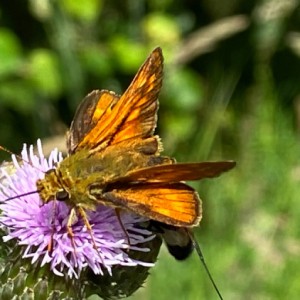MONO MONDAY - BUT NOT BLACK AND WHITE!
It was a very sunny but blustery morning but the wind has kept the rain away, so after a lovely long chat with Margaret, an old friend, I decided to go out for a walk, because I had another chat booked with a young friend at lunchtime.
I wandered over to my field and got blown around the perimeter, but was still able to sing! I was looking for something for Mono Monday that had different shades of one colour and took several photographs. Then I saw a beautiful butterfly on one of the thistles - see my extra - and when I got home discovered that it was a large Skipper - Mr. HCB said he had never seen one, so I was pleased to be able to show him the one I had taken.
I carried on walking and singing and eventually came to the very large oak tree and remembering that last night on Countryfile on BBC1, they had been finding out the age of another large oak at Charlecote Park, Warwickshire I decided that perhaps this would be a good candidate for the MM challenge. I took the shot but when I got home realised that I should have taken more notice of the girth of the tree, so after my chat with Debbie, my young friend, then making some quiches for tea, I decided to go back over and measure it.
Armed with a tape measure and pencil, off I went, completely forgetting that the tree was surrounded by very large nettles, some almost as tall as me! I did try and get near the tree, but failed miserably, so ended up walking round and round it, eyeing it up. No doubt the man walking his dog in the field thought I was rather strange or mad!
I think that the complete girth of the tree is 14 feet or thereabouts, so going by what I found out from another friend, Mr. Google, if you measure the girth of a tree and then divide it by 2.5 cm - the amount a tree in a parkland grows annually - you can determine the age.
I then found another website courtesy of my Google friend which told me that ancient oaks may show certain characteristics such as very wide trunks, very gnarled, with gnarled roots showing above ground, all of which apply to this oak tree. On the same website it gave a Ready Reckoner for estimating the age of an oak tree, so mine, which as I said was about 14 feet could be 232 years old. The historical connections are that it could have been planted in about 1815 in the reign of George III and another interesting fact is that that is the year of the British victory over Napoleon at the Battle of Waterloo.
So I give you my 232 year old oak tree - with various shades of green - and hope that this will suffice for the MM challenge today. The tree lady or to give her the correct title, the Arborist from Charlecote said that for some reason they didn’t have many acorns on their trees, perhaps because squirrels and deer eat them, but there appeared to be many on my oak tree today so perhaps they don’t get many squirrels in the trees or deer in the field.
I learned so much from the programme last night and from Mr. Google, so hope you have enjoyed learning about this oak tree too. I do know, having seen the leaves, that many of the ash trees around the perimeter of the field are suffering from ash die-back disease, but I don't suppose they will be taken down because the Council doesn't have money to do that.
“Of all the trees that grow so fair,
Old England to adorn,
Greater are none beneath the sun,
Than Oak and Ash and Thorn.”
Rudyard Kipling : A Tree Song


Comments
Sign in or get an account to comment.


